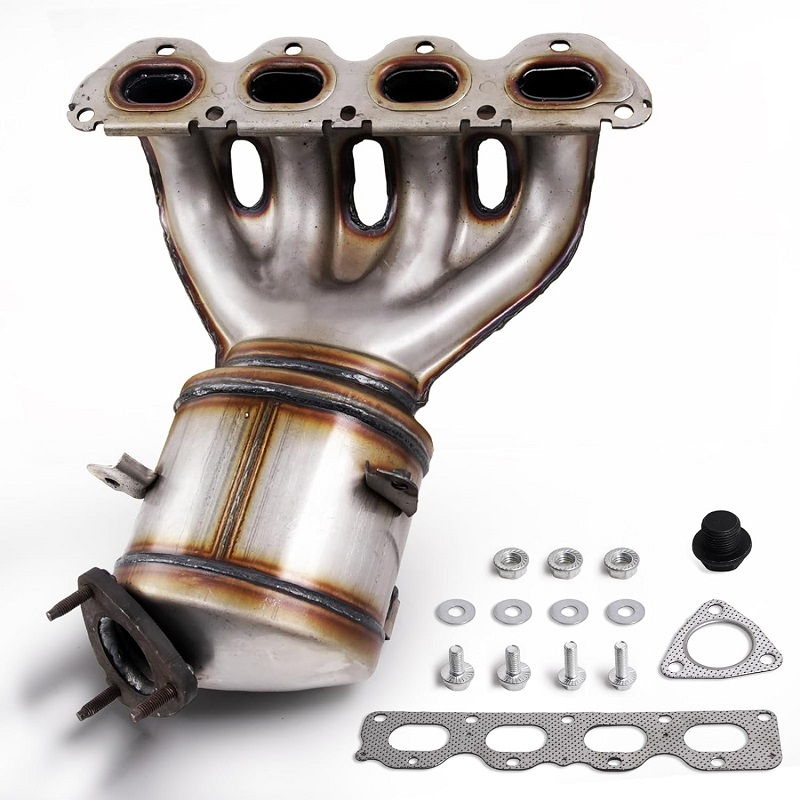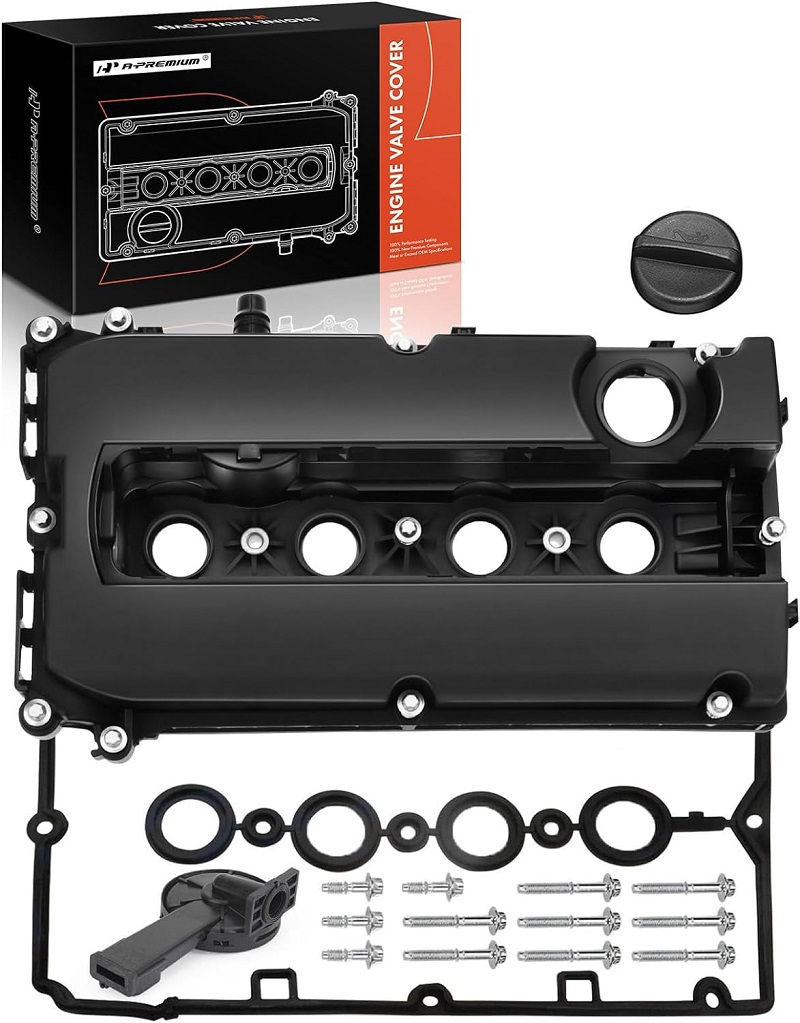This post contains affiliate links. This means I will make a commission at no extra cost to you should you click through and make a purchase [ “As an Amazon Associate, I earn from qualifying purchases.” ]. Read the full disclosure here.
Chevy Cruze Catalytic Converter GuideMechanic.Com Are you a proud owner of a Chevy Cruze? If so, then you must be aware of the importance of the catalytic converter in your vehicle.
Designed to reduce harmful emissions and ensure compliance with environmental regulations, the catalytic converter plays a crucial role in the overall functioning of your Chevy Cruze.
In this comprehensive guide, we will delve into the details of the Chevy Cruze catalytic converter, its significance, common issues, and maintenance tips.
Understanding the Catalytic Converter
Check out this Aumzong 674-841 Manifold Catalytic Converter Fit for 2011 2012 2013 2014 2015 2016 Chevrolet Cruze Sonic 1.8L (EPA Compliant)

The catalytic converter is a key component of the exhaust system in your Chevy Cruze. It is responsible for converting harmful gases produced during the combustion process into less harmful substances before they are released into the atmosphere.
The main function of the catalytic converter is to reduce the levels of nitrogen oxides, carbon monoxide, and hydrocarbons in the exhaust gases.
See Also: 2015 Chevy Cruze Water Pump
The catalytic converter consists of a honeycomb-like structure made of ceramic or metal that is coated with catalysts such as platinum, palladium, and rhodium.
These catalysts facilitate chemical reactions that convert harmful gases into less harmful compounds. The structure of the catalytic converter allows for a large surface area, maximizing the contact between the exhaust gases and the catalysts.
How Does the Catalytic Converter Work?
The catalytic converter operates through a series of chemical reactions known as redox reactions. It contains two main components: the reduction catalyst and the oxidation catalyst. As the exhaust gases flow through the catalytic converter, they encounter these catalysts and undergo several transformations.
1. Reduction Catalyst: The reduction catalyst is responsible for converting nitrogen oxides (NOx) into nitrogen (N2) and oxygen (O2). It achieves this by facilitating the reaction between NOx and carbon monoxide (CO) present in the exhaust gases. This reaction produces nitrogen and carbon dioxide (CO2).
2. Oxidation Catalyst: The oxidation catalyst plays a crucial role in converting carbon monoxide (CO) and unburned hydrocarbons (HC) into carbon dioxide (CO2) and water (H2O). It facilitates the reaction between these harmful gases and oxygen (O2) present in the exhaust gases.
Overall, the catalytic converter acts as a chemical filter, transforming toxic gases into less harmful substances through a combination of reduction and oxidation reactions.
The Significance of a Well-Functioning Catalytic Converter
A properly functioning catalytic converter is essential for the optimal performance of your Chevy Cruze. It not only reduces harmful emissions but also ensures compliance with environmental regulations. Here are some key reasons why a well-functioning catalytic converter is significant:
1. Environmental Impact: The primary purpose of the catalytic converter is to reduce harmful emissions that contribute to air pollution.
By converting nitrogen oxides, carbon monoxide, and hydrocarbons into less harmful compounds, the catalytic converter plays a vital role in minimizing the ecological footprint of your vehicle.
2. Legal Compliance: Catalytic converters are mandatory in most countries due to stringent emission regulations. Failure to have a functional catalytic converter can result in hefty fines and even vehicle impoundment in some cases. Therefore, ensuring the proper functioning of your catalytic converter is crucial to meet legal requirements.
3. Engine Performance: A faulty catalytic converter can negatively impact your Chevy Cruze’s performance. It can cause decreased power, reduced fuel efficiency, and even engine misfires. By maintaining a well-functioning catalytic converter, you can ensure optimal engine performance and smooth operation.
4. Longevity of Other Engine Components: A malfunctioning catalytic converter can lead to the accumulation of harmful substances in the engine, such as carbon deposits. Over time, these deposits can damage other engine components, including the oxygen sensors and spark plugs.
By keeping your catalytic converter in good condition, you can prevent costly repairs and extend the lifespan of other engine parts.
Signs of a Failing Catalytic Converter

As a Chevy Cruze owner, it is important to be aware of the signs that indicate a failing catalytic converter. Recognizing these symptoms early on can help you address the issue promptly and prevent further damage. Here are some common signs to watch out for:
1. Check Engine Light
One of the most common indications of a faulty catalytic converter is the illumination of the “check engine” light on your dashboard.
The onboard diagnostic system in your Chevy Cruze detects abnormalities in the exhaust system and triggers the warning light to alert you of a potential issue.
See Also: 2014 Chevy Cruze Coil Pack
While the check engine light can indicate various problems, a failing catalytic converter is often one of the culprits.
2. Decreased Engine Performance
A failing catalytic converter can cause a noticeable decrease in your Chevy Cruze’s engine performance. You may experience reduced power, sluggish acceleration, or difficulty maintaining consistent speed.
This can be attributed to the restricted flow of exhaust gases caused by a clogged or damaged catalytic converter.
3. Unusual Exhaust Odors
If you start noticing strange odors emanating from your vehicle’s exhaust, it could be a sign of a failing catalytic converter. A malfunctioning converter may produce a rotten egg smell due to the presence of excessive sulfur compounds.
Additionally, you may detect a burning or metallic odor, indicating overheating or physical damage to the catalytic converter.
4. Louder Exhaust Noise
A failing catalytic converter can also cause an increase in the noise level of your Chevy Cruze’s exhaust system.
This can be attributed to internal damage or a loose substrate within the catalytic converter. If you notice a sudden change in the exhaust noise, it is advisable to have your catalytic converter inspected.
5. Failed Emissions Test
If your Chevy Cruze fails an emissions test during vehicle inspection, it may be due to a malfunctioning catalytic converter.
The converter’s inability to effectively reduce emissions can result in higher pollutant levels, causing the vehicle to exceed the permitted limits. In such cases, it is essential to have your catalytic converter inspected and repaired or replaced as necessary.
Common Issues and Causes
While the catalytic converter is designed to be durable, it can still experience issues over time. Understanding the common problems and their causes can help you identify potential concerns with your Chevy Cruze’s catalytic converter. Here are some typical issues and their associated causes:
1. Clogging
Clogging is one of the most prevalent problems encountered with catalytic converters. Over time, a build-up of carbon deposits, oil, and other contaminants can accumulate within the converter, obstructing the flow of exhaust gases.
This can lead to poor engine performance, reduced fuel efficiency, and increased emissions. The primary causes of clogging include engine oil consumption, rich fuel mixture, and the presence of excessive unburned hydrocarbons.
2. Overheating
Excessive heat can cause significant damage to the catalytic converter. Overheating can occur due to various factors, such as misfiring spark plugs, a malfunctioning oxygen sensor, or a fuel system issue.
When the catalytic converter reaches extremely high temperatures, the catalysts can deteriorate, resulting in reduced efficiency and potential failure.
3. Contamination
Contamination of the catalytic converter can occur when foreign substances enter the exhaust system. This can include coolant or oil leaks, which introduce harmful substances into the converter.
Contamination can impair the function of the catalysts and reduce the converter’s effectiveness in reducing emissions.
4. Physical Damage
The catalytic converter can sustain physical damage due to various factors, including road debris, speed bumps, or accidents.
Physical damage can result in cracks, dents, or even complete dislocation of the converter. Such damage can impede the flow of exhaust gases and compromise the converter’s ability to reduce emissions effectively.
5. Oxygen Sensor Failure
Oxygen sensors play a crucial role in monitoring the oxygen levels in the exhaust gases. They provide feedback to the engine control unit (ECU) to adjust the air-fuel mixture for optimal combustion.
If an oxygen sensor fails, it can cause an imbalance in the air-fuel ratio, leading to increased emissions and potential damage to the catalytic converter.
Diagnostic and Repair Procedures

When you suspect a problem with your Chevy Cruze’s catalytic converter, it is essential to perform appropriate diagnostics and follow the necessary repair procedures. Here are the steps involved in identifying and addressing a faulty catalytic converter:
1. Diagnostic Process
Diagnosing a failing catalytic converter requires a systematic approach to rule out other potential issues. Here are the steps involved in the diagnostic process:
Step 1: Retrieve Error Codes
Use an OBD-II scanner to retrieve error codes stored in the vehicle’s onboard diagnostic system. These codes can provide valuable insights into the specific issue affecting the catalytic converter.
Step 2: Visual Inspection
Perform a visual inspection of the catalytic converter and its surrounding components. Look for signs of physical damage, leaks, or loose connections. Inspect the exhaust system for any abnormalities, such as excessive rust or corrosion.
Step 3: Testing Oxygen Sensors
Check the functionality of the oxygen sensors using a multimeter or diagnostic tool. Compare the readings to manufacturer specifications to determine if any sensors are faulty. Faulty oxygen sensors can contribute to catalytic converter issues.
Step 4: Exhaust System Analysis
Perform an exhaust system analysis to measure the emissions and determine if they are within the acceptable limits. This step can help identify whether the catalytic converter is effectively reducing emissions or if it requires attention.
2. Repair or Replacement
Once you have identified a faulty catalytic converter, you have two options: repair or replacement. The choice depends on the severity of the issue and the extent of damage to the converter.
Repair:
If the catalytic converter has minor issues, such as clogging or contamination, it may be possible to repair it.
Professional cleaning or declogging services can remove built-up deposits and restore the converter’s functionality. However, it is essential to consult with a qualified mechanic to determine if repair is a viable option.
Replacement:
In more severe cases, replacement may be necessary. If the catalytic converter is extensively damaged, physically compromised, or has reached the end of its lifespan, replacing it with a new one is the recommended course of action.
See Also: Chevy Cruze Mass Air Flow Sensor
Ensure that you choose a catalytic converter that meets the specifications of your Chevy Cruze and adheres to emission standards.
It is crucial to note that catalytic converter repair or replacement should be performed by a qualified professional. They have the expertise and equipment to ensure proper installation and compliance with regulations.
Maintenance Tips for Prolonging Catalytic Converter Lifespan
Taking proactive measures to maintain your Chevy Cruze’s catalytic converter can help extend its lifespan and prevent potential issues. Here are some essential maintenance tips:
1. Follow Recommended Service Intervals
Adhere to the manufacturer’s recommended service intervals for your Chevy Cruze. Regular maintenance, including oil changes, air filter replacements, and spark plug inspections, can prevent engine issues that may indirectly affect the catalytic converter.
2. Use High-Quality Fuel
Using high-quality fuel with the recommended octane rating can prevent the accumulation of harmful deposits in the catalytic converter. Low-quality or contaminated fuel can introduce impurities that affect the converter’s performance. Choose reputable fuel stations and avoid fuel with an unknown source.
3. Avoid Engine Overheating
Prevent your Chevy Cruze’s engine from overheating by ensuring the cooling system is in good condition. Regularly check coolant levels and have the cooling system inspected by a professional. Overheating can damage the catalytic converter and other engine components.
4. Address Engine Issues Promptly
If you notice any signs of engine trouble, such as misfires, rough idling, or a decrease in performance, address them promptly. Ignoring engine issues can lead to increased emissions and potential damage to the catalytic converter.
5. Avoid Excessive Idling
Extended periods of idling can increase the risk of catalytic converter damage. If you need to wait for an extended period, consider turning off the engine to minimize unnecessary wear on the converter.
6. Protect from Physical Damage
Take precautions to protect your catalytic converter from physical damage. Avoid driving over speed bumps or rough terrain at high speeds. Be cautious of road debris that could potentially impact the converter.
7. Regularly Inspect and Clean Oxygen Sensors
Keep an eye on the oxygen sensors and ensure they are clean and functioning correctly. Dirty or faulty sensors can affect the air-fuel mixture, leading to increased emissions and potential catalytic converter damage. Consult your vehicle’s manual for specific instructions on sensor maintenance.
8. Routinely Check for Leaks
Inspect the exhaust system for any signs of leaks, such as sooty residue or hissing sounds. Leaks can introduce contaminants into the catalytic converter, affecting its performance. Address any leaks promptly by replacing faulty gaskets or damaged components.
Upgrading to High-Performance Catalytic Converters
If you are looking to enhance the performance of your Chevy Cruze or explore aftermarket options, upgrading to a high-performance catalytic converter may be an option. Here are some considerations and potential benefits:
1. Increased Flow and Power
High-performance catalytic converters are designed to offer improved flow characteristics compared to stock converters. This can result in increased horsepower and torque, enhancing your Chevy Cruze’s performance.
2. Enhanced Sound and Exhaust Note
Certain high-performance catalytic converters can provide a more aggressive exhaust note, giving your Chevy Cruze a sportier sound.
See Also: 2013 Chevy Cruze Water Pump
However, it is essential to ensure that the sound complies with local noise regulations, as excessively loud exhaust systems may be subject to legal penalties.
3. Compliance with Emission Standards
When considering a high-performance catalytic converter, ensure that it meets the emission standards of your region. It is crucial to strike a balance between performance improvements and environmental responsibility.
4. Manufacturer Warranty Considerations
Upgrading to an aftermarket catalytic converter may void the manufacturer’s warranty. Before making any modifications, carefully review your vehicle’s warranty terms and consult with an authorized dealer or mechanic.
5. Installation and Tuning
Installing a high-performance catalytic converter may require modifications to your Chevy Cruze’s exhaust system.
It is recommended to have the installation performed by a professional who specializes in aftermarket modifications.
Additionally, tuning the engine control unit (ECU) may be necessary to optimize performance and ensure proper fuel-air mixture ratios.
It is important to research and select a reputable brand when considering an upgrade to a high-performance catalytic converter.
Consult with experts or online communities to gather insights and recommendations based on your specific performance goals and requirements.
See Also: Alternator For 2013 Chevy Malibu
- P008D Fuel Cooler Pump Control Circuit Low - October 30, 2024
- P008E Fuel Cooler Pump Control Circuit High - October 26, 2024
- P008F Engine Coolant Temperature/Fuel Temperature Correlation - October 4, 2024
